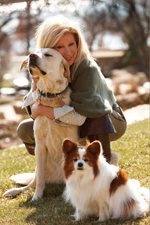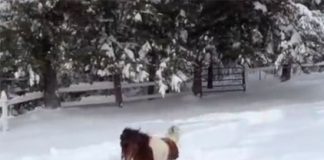 In 2008, philanthropist and animal lover Madeleine Pickens made headlines around the world when she offered to rescue 33,000 wild horses and burros that are under the care of the U.S. Bureau of Land Management (BLM). Pickens has fought horse slaughter for years. These days, the wife of billionaire T. Boone Pickens is working hard to negotiate the purchase of private land to create a sanctuary for the equines and navigate the inevitable legislative red tape that has slowed the process.
In 2008, philanthropist and animal lover Madeleine Pickens made headlines around the world when she offered to rescue 33,000 wild horses and burros that are under the care of the U.S. Bureau of Land Management (BLM). Pickens has fought horse slaughter for years. These days, the wife of billionaire T. Boone Pickens is working hard to negotiate the purchase of private land to create a sanctuary for the equines and navigate the inevitable legislative red tape that has slowed the process.
HI: What is it about saving these wild horses that is important to you?
MP: Wild horses on federal land are living symbols of the history of the American West and must be protected. I want to create a wild horse sanctuary that will be a destination where Americans and tourists from around the world can observe and be a part of this history. If we can establish a plan for the permanent retirement and care of these magnificent animals, it will be a legacy that all Americans can be proud of.
HI: How did you get involved in horse rescue?
MP: My husband and I rescued about 800 dogs and cats after Hurricane Katrina. During that time, I met a woman who opened my eyes to the horrors of horse slaughter. I had been a very successful Thoroughbred breeder with my former husband, the late Allen Paulson. We bred Cigar, the Hall of Fame racehorse who was America’s richest racehorse in lifetime earnings until 2008. Cigar is now 19 and lives in retirement at the Kentucky Horse Park’s Hall of Champions. I was heart-broken and disgusted to learn that probably 80 percent of the horses that I bred ended up in the slaughterhouse. As a result, my husband, T. Boone Pickens, and I have fought horse slaughter for years. Just a few years ago, we helped close the last equine slaughterhouse in the United States.
HI: Do you ride or have any horses of your own?
MP: We have one retired racehorse that lives on our ranch, which runs along the Canadian River in the Texas panhandle. I wish I could ride, but unfortunately I have vertigo, so I won’t put myself on a horse for fear of getting dizzy and falling. I would love to ride, but it’s just something I don’t do anymore. I will never stop loving horses, though.
HI: What happened when you heard about the fate of the wild horses and burros in the BLM’s care?
MP: When I heard that the BLM was planning to euthanize 33,000 horses, I cried and I prayed for help in coming up with a solution. The next day I organized a team of people to look for a ranch. Then I went to the BLM and asked if it would let me rescue all the horses if I bought enough land. I wasn’t prepared for all the media attention, but I think there was so much interest because it was a story with a potentially happy ending. The media generally stays away from the topic of horse slaughter because it’s so awful.
HI: What do you hope the public takes away from watching your vision turn into reality?
MP: Journalists from all over the world have told me this story captivated them because they love the lore of American cowboys and Mustangs. I think Americans don’t realize the treasure they have when it comes to wild Mustangs. Imagine the wonderful experiences one could have at the type of ranch I envision: Boy Scouts, Girl Scouts and families camping or staying in log cabins and teepees, watching wild horses running free. The land never stops giving.
HI: What are your plans for the sanctuary?
MP: We’ve been looking to purchase about a million acres in Nevada. It will be a place where anyone can go to see wild horses running free. We’ve had a lot of pushback from cattlemen in that state, but what we’re doing has nothing to do with them. We’re not going to put the horses on their private ranches.
HI: What can people do to help?
MP: To learn more about our efforts, visit www.madeleinepickens.com. But the most important thing horse owners can do is breed responsibly and plan for the future of their horses. In this country, we breed horses by the hundreds of thousands every year. But there’s little accountability for exit strategies for our horses. There is tremendous beauty in the retirement of an older animal.
HI: As of January 2009, the Mustangs are still in the BLM’s care. What’s the latest news?
MP: There are still a lot of moving parts to this project. We’re dealing with the BLM and managing a wonderful but overwhelming number of supporters who want to be involved. As much as the BLM would like this whole thing to go away, we have put it on the front burner and showed them that the American people do not want wild horses and burros to be euthanized. But the cogs in the wheels of Washington are slow. We have also hit a period of transition with a new president. There are people trying to make this work, so hopefully we will be on our way soon. Another factor is that once we have the land approved, we will have a lot of work to do before we can take in the horses, such as making sure we have enough water in the right places and a feeding plan worked out. This won’t happen overnight, but we’re on course and we’re very excited.
Update
In late March 2009, just a few days before the cherry blossoms hit their peak in our nation’s capital, Madeleine Pickens visited Washington, DC to continue efforts to strike a deal with the Bureau of Land Management (BLM). “When two people want to make a deal, they can,” she said. Pickens expressed optimism that when the Obama administration appoints a director to the BLM, he or she will be on board with our plan.
“Tax payers deserve a better deal,” said Pickens. “At a time when our country is providing bailouts and stimulus packages, why should American tax payers spend a billion dollars over the next decade to take care of the situation?” The short-term holding, she explained, was created simply for gathering and holding wild horses and mustangs in preparation for transporting to long-term holding. These 30,000 horses have been in short term housing for three years.
The National Wild Horse Foundation (established by Pickens to support this cause) also has an action alert on its website asking for help at the grassroots level. “We’re asking the public to contact Department of the Interior Secretary Ken Salazar and ask him to listen to our plan to stop the needless slaughter and imprisonment of thousands of America’s wild horses and burros,” she said.







I applaud Mrs Pickens for her love of the horses. I hope the BLM allows the wild ones to go live in a safe place although I read an awful lot of negative things coming out of the BLM concerning her plan. Let’s hope money talks and the horses get a home. I have two BLM mustangs of my own–I’d take more but I can only feed so many.
great idea!
There will be a special place for you in the after life Mrs Pickens. You’ll be riding again with no fear of falling and you won’t run into Salazar there either I’m SURE of that!!
I am wondering about the date of the interview since she has already opened a sanctuary in NV. Looks like old news…
Wonder no more, Sally. It says July 2009 right at the bottom of the article.
Just waiting for an update from the Aug 2012 horse ecosanctuary proposal which the BLM is considering. Keep your fingers crossed!!!
I think you are on track with your comments a we feel the same way as you.let us know how we can help you with you mission we are here to help get the job done.